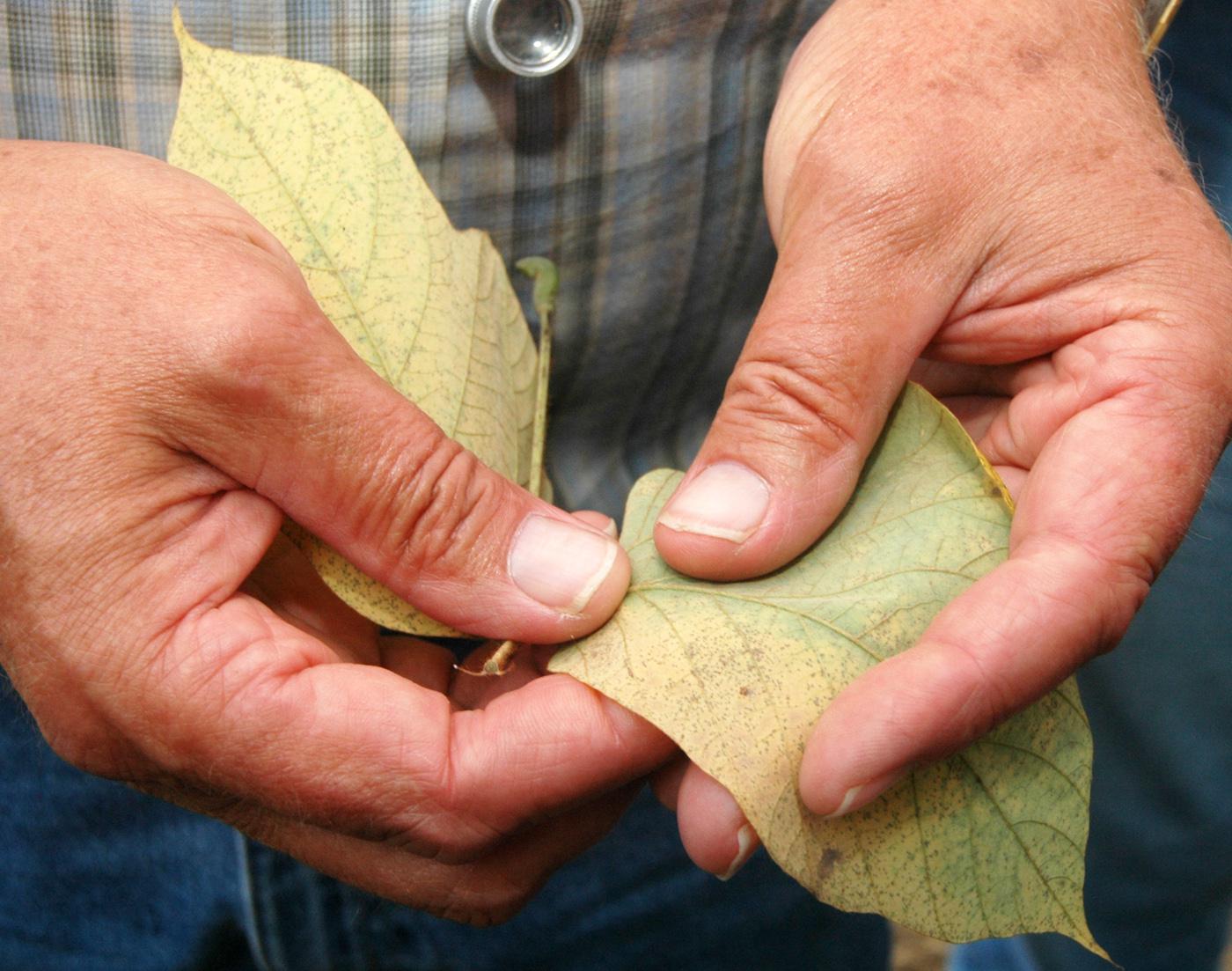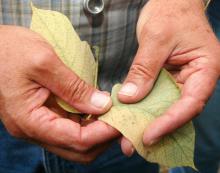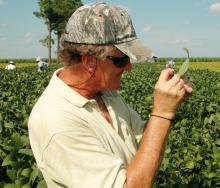Information Possibly Outdated
The information presented on this page was originally released on August 16, 2007. It may not be outdated, but please search our site for more current information. If you plan to quote or reference this information in a publication, please check with the Extension specialist or author before proceeding.
Tour takes producers to soybean rust sites
MISSISSIPPI STATE -- Most Mississippi farmers have never seen Asian soybean rust in their fields and hope to never encounter the yield-robbing disease in their crop.
Soybean producers throughout the state, however, are being educated about the disease and one group recently had the opportunity to see the disease on plants. About 35 Mississippi producers, agricultural chemical company representatives, crop consultants and Mississippi State University Extension Service personnel spent Aug. 6 and 7 touring sites where rust has been found in east Louisiana and southwest Mississippi.
The 2007 tour was organized by MSU-ES with support from the Mississippi Soybean Promotion Board and was led by members of the Extension soybean rust scouting team. The team includes Billy Moore, Extension plant pathologist emeritus; Alan Henn, associate Extension professor of entomology and plant pathology; and Tom Allen, Extension plant pathologist.
Asian soybean rust first appeared in Japan in 1902 and has since moved across Asia, Africa and South America. It made its first appearance in the United States in 2004, and the first confirmed case in Mississippi was in late fall 2004. Once a plant is infected, it can be completely defoliated by soybean rust.
The first stop on this year's tour was Louisiana State University facilities in the Alexandra area, where the participants saw infested fields.
“The fields we saw south of Alexandra did have soybean rust that had been treated with fungicide, which had stopped the disease,” Moore said. “Even though the rust was no longer active, we did see what fungicide treatments do to the disease.”
The following day, the tour participants saw the only location where soybean rust had been found in Mississippi at that time—kudzu near Woodville in Wilkinson County. Kudzu is a host plant for soybean rust and monitoring the state's estimated 250,000 acres of kudzu is part of the first line of defense against the disease.
The first 2007 report of the disease in a Mississippi producer's field was made on Aug. 15 in Sunflower County. Earlier in the week, the disease was found in sentinel plots in Pearl River and Washington counties.
“Sentinel plots are small areas planted to soybeans throughout the state specifically to monitor for rust,” Moore said. “If rust spores are found in kudzu or sentinel plots, we can alert producers in surrounding areas of the need to apply fungicides to protect against the disease.”
The sentinel plots are planted in late February and early March so they will be susceptible to soybean rust before producers' fields are susceptible.
The early warning is a critical part of heading off a major outbreak of the disease because of the way rust spreads and reproduces. Spores from infected plants can be carried by the wind but only remain viable for a limited time in intense sunlight.
“The spores are only viable for a short time,” Henn said. “From the time a spore lands on a leaf until it enters the plant and produces new spores is about seven to nine days under optimum conditions, which include temperatures between 67 and 77 degrees. During that time it is susceptible to certain fungicide applications.”
The early warning about the potential for a rust outbreak is important for producers, said tour participant Mike Pannell of Union County.
“We are looking for timely recommendations from the university about when and what to spray for rust control,” he said. “You can waste money on products that don't work or make applications at the wrong time.”
Rust has been found as far north as Oklahoma, which has had the temperatures and moisture it needs, Moore said. He noted that all soybean varieties are susceptible, but environmental conditions play a big role in both the diseases development and soybean losses.
“We have about 200,000 acres of soybeans that were planted behind wheat this summer, so while most of the state's crop is beyond the stage where rust will have time to cause damage, those late-planted beans could still be damaged,” Moore said.
The tour participants learned about research currently underway to produce genetic resistance to soybean rust. They also received pointers on identifying the disease, which is hard to distinguish from some other soybean diseases.
“Being on the tour showed me the difference in soybean rust and other diseases,” Pannell said. “I still may not be able to positively identify it, but what I've learned will help me eliminate it as a possibility if what I'm looking at is another disease.”
The effort to monitor the disease and provide producers advanced warning has been one of the most well coordinated he as seen in more than 40 years as a plant pathologist, Moore said.
“The U.S. Department of Agriculture, Extension, research scientists and producer organizations in northern states and across the South are all working together on this problem,” he said. “Teams like ours can't, however, cover all the fields in the state, so it's important to have producers who can help spot the disease in their fields.”
For soybean rust updates, call the toll-free soybean rust hotline at 1-866-641-1847.
Contact: Dr. Billy Moore, (662) 325-2086








